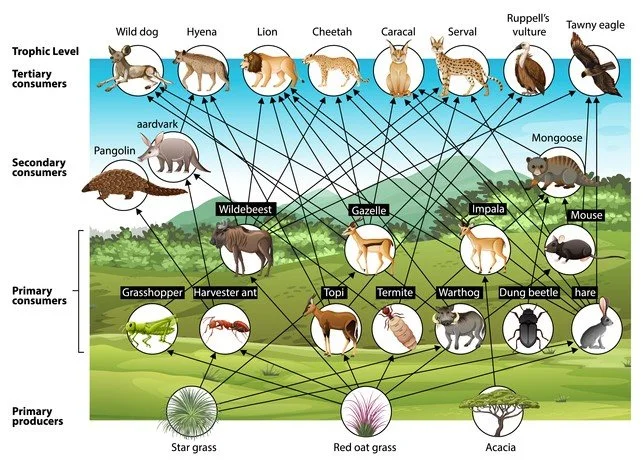The Incredible Human Part Four: Man, The Cucinivore
We usually consider animals' diets carnivorous, herbivorous, or omnivorous. However, within the distinction of herbivores, we see further specializations. For example, frugivores eat fruits primarily, granivores eat grains and seeds, and folivores eat leaves. Humans are omnivores. But there is more to our dietary story. Just as herbivores can specialize as frugivores, granivores, folivores, or a combination, omnivores also specialize, especially humans.
Trophic Levels
The specific type of diets that animals have is better described using the term trophic level. I have written about trophic levels in detail here if you want more information. Trophic levels represent species' positions in a food web, from primary producers to apex predators. For example, plants are trophic level 1. To determine the trophic levels of animals, we take the trophic levels of food items in a species' diet, weighted by quantity, and add one. For example, cows feed on plants (trophic level 1); thus, their trophic level is 2. On the other hand, polar bears or killer whales are highly predatory and have trophic levels that range up to 5.5.
Bonhommeau and fellow researchers have determined modern humans living today have a trophic level of 2.21. This designation puts us in the realm of pigs and anchovy fish. Slight differences in a species' trophic level can reflect significant differences in diet. For instance, the people of Burundi had a trophic level of 2.04, representing a 96.7% plant-based diet, compared to Iceland, where they eat 50% meat and 50% vegetables and have a trophic level of 2.57. 1
Paleolithic Processed Foods
Humans have been using stone tools for about 2.6 million years and possibly as long as 3.4 million years. The earliest stone tools may not have been shaped by early hominins. Instead, they may have used nearby stones to break open animal remains to extract their energy-rich fat and bone marrow, and brains. 2 Butchering with tools is a form of food processing. Although primitive, tool use would have provided much more energy to our diets without spending much time procuring it. 3 In The Incredible Human Part One, I also spoke about the changes to our legs, hands, and shoulders that enabled us to grasp tools and throw rocks, further improving our ability to procure nutrients. Because meat is rich in nutrients, including essential amino acids, it may have spurred the increase in brain size. 4 Either way, food processing, although minimal, provided direction in our evolution from apes to humans. Lastly, storage, drying, marination, and fermentation, have been with us for long periods and provide easier digestion, additional palatability, and more nutrients.
Fire
Humans are unique in many ways, and our use of fire is a distinguishing hallmark of being human. Fire can be used to keep warm, protect, manage the landscape, make tools, communicate, and provide better night visibility. The jury is out on controlled human fire use. Some researchers believe it may be 1.8 million years old. Humans certainly controlled fire from about 350,000 to 500,000 years ago. 5 But today, I want to focus on the use of fire for cooking. In 2008, researchers determined that apes prefer cooked food over their natural diet of uncooked leaves. This preference led them to conclude that we were preprogrammed to desire cooked foods, which we may have encountered after wildfires. So even before we could control the use of fire, we may have had cooked foods sometimes, and even desired it. 6
The hypothesis that cooked diets provide more energy and nutrients is corroborated by the fact that people on raw diets can suffer from diminished physical and mental performance. Mechanisms contributing to the energy gained from cooking include:
Increased digestibility of starch and protein.
Reduced costs of digestion for cooked versus raw meat.
Reduced energetic costs of detoxification and defense against pathogens. 7
Cooking
No humans have been recorded as living without cooking food, and cooking is unique to humans. However, suppose cooking is obligatory for humans but not, as I mentioned previously, for apes. In that case, this means that human biology must have adapted to the ingestion of cooked food in ways that no longer allow efficient processing of raw foods. For example, many plant foods are too fiber-rich when raw, while most raw meat appears too tough to allow easy chewing for modern humans with smaller teeth and jaws. Lastly, cooking has been around long enough for us to evolve other changes like smaller colons, smaller cecums (a pouch for fermentation of fiber), larger small intestines, faster digestion, and possibly reduced detoxification ability. 8 Apes, on the other hand, have larger stomachs, huge cecums, and colons for fermenting leaves.
We Are Cucinivores
The evolutionary changes in our guts are almost too profound to ignore the evolutionary influence of preparing and cooking food. Humans have consumed cooked foods for around 250,000 to 400,000 years. There would have been 12,000 generations in that time, enough time for our digestive tracts to have modified. 9 Looking further back in our evolutionary journey from the apes, the increase in the size of our brains is out of proportion to all of the other apes and primitive humans. This is because Kleiber's law postulates the size of an animal, and the ratio of their brain size is determined by diet. Our higher-quality diet from preparing and cooking foods accounts for this. 10 Lastly, some anthropologists think cooked tubers like yams played a prominent recent role in our large brains. The increase in hominin brain size started with meat consumption but accelerated only relatively recently. 11 Our reliance on high-quality foods is not all good. In times of starvation, our poor ability to digest plant-based foods is a liability. Sadly, there is increasing pressure to do away with animal-based foods. However, because we are omnivores, and animal-based foods were critical to our evolution and continue to be essential for good health, we should not eliminate them. Also, making foods too highly palatable can lead to low-quality food choices, overeating, and, subsequently, poor health. Whether a vegetarian, omnivore, or carnivore, you will most likely consume cooked and prepared foods today. Enjoy your cucinivory!





